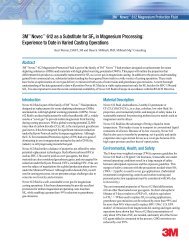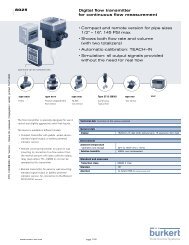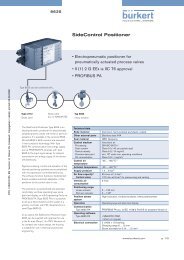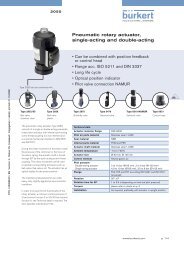Solenoid valves - Bürkert Fluid Control Systems
Solenoid valves - Bürkert Fluid Control Systems
Solenoid valves - Bürkert Fluid Control Systems
You also want an ePaper? Increase the reach of your titles
YUMPU automatically turns print PDFs into web optimized ePapers that Google loves.
2.3.2. Servo-assisted solenoid<br />
<strong>valves</strong> with piston<br />
A plunger-type solenoid is used as the<br />
pilot valve with this principle as well,<br />
but the main valve function is implemented<br />
by a piston. The function of<br />
this valve (e.g. Types 5404 and 6221)<br />
results from the fact that fluid is also<br />
able to flow from the supply P through<br />
a control bore in the piston or bypass<br />
channel of the main valve. If the chamber<br />
above the piston is closed off with<br />
the pilot valve de-energized, the fluid<br />
system pressure builds up there as<br />
well and the piston, which simultaneously<br />
forms the valve seal, closes the<br />
valve seat in the main valve.<br />
It is assumed that the fluid pressure<br />
can be discharged in outlet A. For as<br />
long as a pressure differential exists<br />
between the inlet port and the outlet<br />
port, the main valve remains closed as<br />
the result of the closing forces above<br />
the piston. After activating the pilot<br />
valve, the pressure in the chamber<br />
above the piston is able to drop. The<br />
force acting on the lower side of the<br />
piston as the result of the fluid system<br />
pressure is greater than that on the<br />
upper side of the piston, it lifts the piston<br />
and opens the main valve. Servoassisted<br />
solenoid <strong>valves</strong> operating on<br />
the basis of this design require a minimum<br />
pressure differential for correct<br />
opening and closing. <strong>Solenoid</strong> <strong>valves</strong><br />
with a coupling (forced valve lifting)<br />
between the solenoid core and piston<br />
(e.g. Type 407) require no pressure<br />
differential for switching. Servo-assisted<br />
piston-operated <strong>valves</strong> are used<br />
chiefly in applications with high pressures,<br />
gaseous media and steam up<br />
to 180 °C.<br />
Advantages:<br />
■ More robust than servo-assisted<br />
solenoid <strong>valves</strong> with diaphragm<br />
■ Higher pressure range<br />
■ Suitable for gases and steam.<br />
Disadvantages:<br />
■ More expensive than servo-assisted<br />
solenoid <strong>valves</strong> with diaphragm<br />
■ Less damping of closing impact<br />
■ Require higher pressure differential<br />
for opening.<br />
Electrical<br />
connection<br />
Pilot valve<br />
Return spring<br />
<strong>Solenoid</strong> coil<br />
P<br />
Core, plunger<br />
Piston<br />
Restrictor port<br />
Main valve<br />
Valve body<br />
Valve seat<br />
A<br />
Figure 6:<br />
Servo-assisted 2/2-way solenoid valve, normally closed, with piston.<br />
Shown closed at left and open at right<br />
24/25








